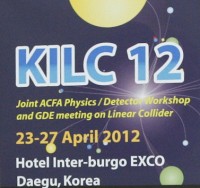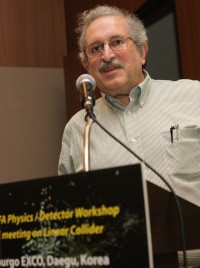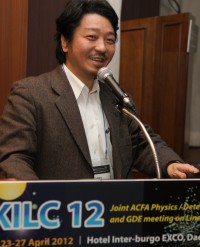A workshop organised by the Asian Committee on Future Accelerators (ACFA) and the ILC Global Design Effort (GDE) was held in Daegu, Korea from 23 to 27 April 2012. The central emphasis of this workshop was the final discussions of the technical systems for the ILC, before we launch full-fledged into producing the Technical Design Report for the accelerator and the Detailed Baseline Design (DBD) report for ILC detectors. Both reports will be produced in final draft forms before the end of this calendar year to be handed over to our oversight committees. The final versions taking into account the comments from these committees will be published in summer 2013. The ACFA workshop was devoted to the study of the physics case for high-energy linear electron-positron colliders, taking into account the recent and projected results from LHC, and reviewed progress on the detectors. For the GDE this meeting represented an important milestone to finalise the baseline and start writing the Technical Design Report, as well as to begin the process of reviewing the detailed ILC cost estimates.
In the opening session, Michael Peskin from SLAC gave a talk on the “Status of the Physics Report for the DBD.” He said that this part of the physics/detector report will serve as an important update on the physics motivation and justification for the ILC. The physics report will consist of an introduction on experimentation at the ILC, the design and benchmarking for each ILC detector (ILD and SiD), and a report on the physics opportunities at the ILC.
Peskin concentrated on the last topic in his talk, emphasising that the DBD Physics Report needs to make a clear physics case for the ILC. He went on to point out that although the case for the next accelerator after the Large Hadron Collider should be based on the knowledge gained from the LHC, we have not gained much of that knowledge yet. The original expectations were that at this point we would have accumulated 100 inverse femtobarn (fb-1) of data at 14 TeV, which should be compared to the present 7 fb-1 with energy that has recently been increased from 7 TeV to 8 TeV. In fact, he pointed out that considering future upgrades, we have probably only seen about 0.1 percent of the eventual data set and therefore most of the LHC physics is still in front of us. Nevertheless, with the added data being accumulated this year, we should have around 20 fb-1, potentially enabling observation of a five-sigma signal, if the present hints lead to a discovery of the Higgs.
The approach being taken for the physics report is to assume that the Higgs will be found, and this report will make the case for why we will then need to study the Higgs in electron-positron annihilations, for example, in order to make model-independent conclusions regarding the Higgs couplings. Peskin proceeded to make the case that studying the physics of the Higgs is so important that we need not and should not wait for longer-term LHC results. He concluded that this will be the right moment to make the case and propose a linear collider. There was related community discussion of precisely this point in a panel discussion the next day. I will discuss the panel discussion next week.
Another interesting and informative talk at KILC12 was given by Satoru Yamashita of Tokyo University on “Japanese Efforts towards ILC.” In his talk, he emphasised the cooperative effort between academia, industry, policy makers and local governments in Japan. He traced the history and status in each of these areas, as well as near-term future plans. In the political arena, efforts are being made through the Federation of Diet Members for promoting the ILC, and Yamashita talked about the close collaboration that has been forged between academia and industry through the Advanced Accelerator Association (AAA) promoting ILC-related science and technology. AAA consists of 84 private companies and 30 public research institutions. Yamashita discussed the two Japanese candidate sites, their characteristics and the future plans in Japan to study these sites.
Yamashita emphasised that broad support from the international community will be a necessary ingredient if a proposal to host the project in Japan is to go forward, and in that respect he pointed to the impact and importance of our site visit last January.
I conclude today by thanking the workshop organisers. Our Korean hosts did an absolutely superb job of organising all aspects of the workshop, including choosing a very good venue for the meeting.





Recent Comments